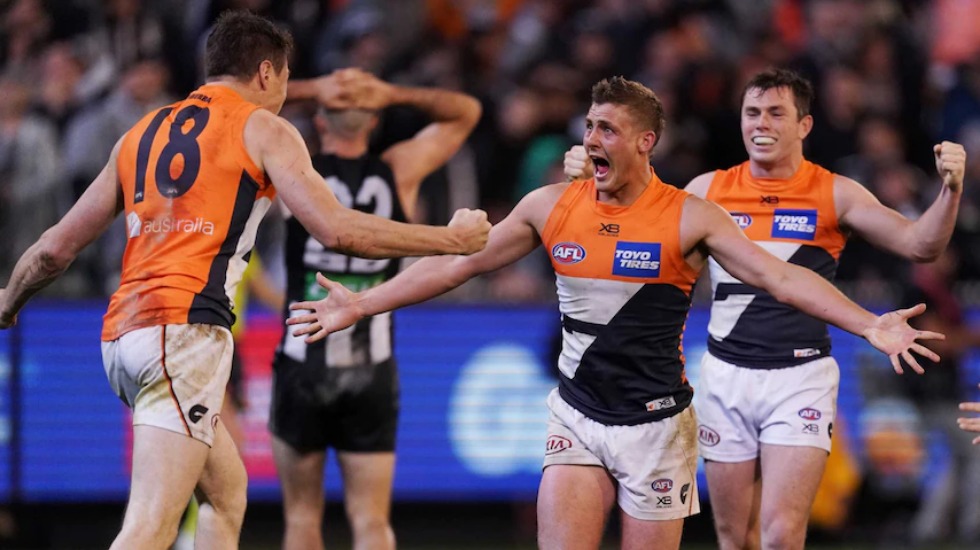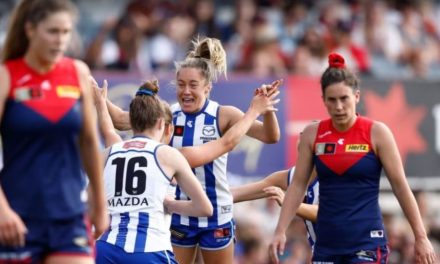Jeremy Cameron (left), Harry Perryman (centre) and Brent Daniels celebrate the Giants’ 2019 preliminary final win. Photo: AAP
The COVID pandemic has again thrown an AFL fixture into chaos, schedules up in the air until, as we saw last weekend, literally the last minute.
The league’s fixturing team have responded superbly. How we ended up watching a full set of nine games last Friday night, Saturday and Sunday is anyone’s guess. There is, though, still a safety valve of sorts should things get even worse via the weekend allotted for the pre-finals bye.
Of course no-one wants this country’s health crisis to deteriorate further. But from the point of view of competition integrity, perhaps using up the pre-finals bye early and playing straight through would actually be preferable.
Yes, we’re talking about the elephant in the room again, the extent to which the pre-finals bye has robbed the top-four teams each year of the advantages they’ve worked for five months to establish. And this season, there’s potential for that elephant to create the most chaos yet.
Before we even argue the case, let’s present some numbers surely even the sceptics can’t deny are significant, after again last year, two qualifying final winners ended up preliminary final losers.
Prior to the introduction of the bye in 2016, 17 of the previous 18 preliminary finals (94 per cent) from 2007-15 had been won by a team which had won its qualifying final, had a week off, then took on a more-fatigued opponent which had been playing every week for months. Since the bye, we’ve had 10 preliminary finals. The record of qualifying final winners in them is 4-6. That winning strike rate has fallen from 94 percent to 40.
That is a massive shift. It underlines just how costly can be the interruption to momentum which occurs to the qualifying final winners, who go from playing a game roughly every seven or eight days to just one in around 27.
Indeed, for Collingwood in 2019, it was just one game (between the final home-and-away round and preliminary final) in 29 days, nearly a full month. Was it really any wonder the Pies finally “woke up” in the preliminary final they lost by a kick to GWS only at three-quarter time?
As was Geelong caught on the hop in the 2016 preliminary final when it conceded seven goals to nothing against Sydney, and Richmond in that famous upset at the hands of Collingwood in 2018.
The numbers keep stacking up badly. And why is it more of an issue in 2021? Because right now the bottom couple of teams in a top eight that may well prove to be a final eight are as ordinary as we’ve seen for some time.
Potentially, we have a situation in which not only are teams good enough to finish top four and win their first final then thrown into a very untimely holding pattern, but forced to play-off for a grand final spot on equal footing against sides whose entire finals credentials were questionable, but who managed to string together just two September wins.
PLEASE HELP US CONTINUE TO THRIVE BY BECOMING AN OFFICIAL FOOTYOLOGY PATRON. JUST CLICK THIS LINK.
The Western Bulldogs’ famous 2016 premiership is always used as the obvious example of how the break before finals greatly benefitted a bottom-half-of-the-eight team, the extra week giving the Dogs the chance to regain five key players before their unlikely elimination final win over West Coast in Perth.
But what Doggies fans rightly get grumpy about when it is cited is the fact that they were also the best seventh-placed team we’ve ever seen, one which won 15 of 22 home-and-away games, good enough to have earned them a top-four spot in each of the three subsequent years.
Indeed, the Dogs had won only one less game than the Eagles that year, ditto the Giants, whom they beat in the preliminary final, and two fewer games than Hawthorn, who they beat in a semi, and their grand final opponent, Sydney.
But whichever sides finish seventh and eighth in a few weeks will most likely have no more than 12 wins, and potentially even just 11. At the other end of the top eight, right now you’d fancy the chances of both the Bulldogs and Geelong finishing with 18 wins.
Let’s play hypotheticals. Geelong finishes on top with 18 wins and has a good victory in the qualifying final. It then waits two weeks, by game day having played one game in as good as a month, to take on West Coast, which scrambled into the eight with just 11 wins, but found enough form to win an elimination final and a semi-final, the pre-finals bye having allowed it to regain a few more injured players.
The Cats have won seven more games than their opponent, which they beat by nearly 100 points during the home-and-away rounds. But in the penultimate game of the season, for a grand final spot, they are in exactly the same position as their opponent, albeit with arguably an inferior preparation.
Yes, a finals system rather than a top-of-the-table premier creates more chance of an upset to the status quo. But when your chances of reaching a grand final as a top-four team good enough to win its first final are running at just 40 per cent, why would you bother investing so much energy in the season proper?
Our game likes underdogs, and it likes upsets. But that should never come at the risk of undermining completely the unfolding narrative we’ve spent the last five months observing.
I said loudly when it was first introduced that I believed the pre-finals bye was a bad idea. Five seasons of its operation have only strengthened that belief. And if we see another two qualifying final winners shot down on preliminary final day this season, particularly by two teams luckier than most to even be part of September, surely more people will realise we’re screwing up how we decide the very thing an entire football season is about.
This article first appeared at ESPN.












Let’s not forget to count Essendon 1990.
The pies and eagles drew in their prelim, the game was replayed a week later, giving Essendon a week off that they didn’t need before the GF.
From memory Sheeds organised the Roys to play a hit out at Windy Hill to keep the boys in form. Alas, the flag went to Collingwood
Love your work RoCo but I would like to think 5 years isn’t really enough of a sample size. In 2017,18 and 19 the premier had won a qualifying final and eventually the premiership, while last year both Port and the Lions could be considered to raw and not battle hardened enough to win their prelims. I felt from 2011-15 the comp had actually grown a bit stale, that the premier and other finalists were pretty much known by July. From 2016-19, I felt differently. I too hated the bye initially and it wouldn’t phase me if it was gone but I’m not in total agreement that the bye is making a mockery of the home & away season. Keep up the good work regardless Rohan
All very good points, but the article fails to address the main reason the bye was brought in, which was to stop the farcical situation late in the season where teams could rest players en masse if they were guaranteed to hold their spot and unlikely to be able to improve it. Lucky for teams fighting for a spot if their opposition are resting players, unlucky if they’re not. The only thing I can think of is to maybe move the bye to a fortnight before the finals.